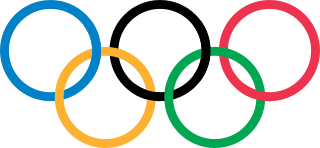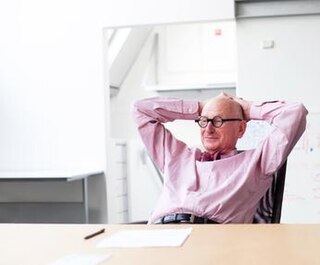
Tate is an institution that houses, in a network of four art galleries, the United Kingdom's national collection of British art, and international modern and contemporary art. It is not a government institution, but its main sponsor is the UK Department for Culture, Media and Sport.
A corporate identity or corporate image is the manner in which a corporation, firm or business enterprise presents itself to the public. The corporate identity is typically visualized by branding and with the use of trademarks, but it can also include things like product design, advertising, public relations etc. Corporate identity is a primary goal of corporate communication, aiming to build and maintain company identity.

Rebranding is a marketing strategy in which a new name, term, symbol, design, concept or combination thereof is created for an established brand with the intention of developing a new, differentiated identity in the minds of consumers, investors, competitors, and other stakeholders. Often, this involves radical changes to a brand's logo, name, legal names, image, marketing strategy, and advertising themes. Such changes typically aim to reposition the brand/company, occasionally to distance itself from negative connotations of the previous branding, or to move the brand upmarket; they may also communicate a new message a new board of directors wishes to communicate.

Rail Alphabet is a neo-grotesque sans-serif typeface designed by Jock Kinneir and Margaret Calvert for signage on the British Rail network. First used at Liverpool Street station, it was then adopted by the Design Research Unit (DRU) as part of their comprehensive 1965 rebranding of the company.

Pentagram is a design firm. It was founded in 1972, by Alan Fletcher, Theo Crosby, Colin Forbes, Kenneth Grange, and Mervyn Kurlansky at Needham Road, Notting Hill, London. The company has offices in London, New York City, San Francisco, Berlin and Austin, Texas. In addition to its influential work, the firm is known for its unusual structure, in which a hierarchically flat group of partners own and manage the firm, often working collaboratively, and share in profits and decisionmaking.

Each Olympic Games has its own Olympic emblem, which is a design integrating the Olympic rings with one or more distinctive elements. They are created and proposed by the Organising Committee of the Olympic Games (OCOG) or the National Olympic Committee (NOC) of the host country. It is the responsibility of the International Olympic Committee (IOC) to approve Olympic emblems for the Olympic games. The Olympic emblems are used in promotional materials, by sponsors of the Olympics, and on the uniforms of every Olympic competitor. All emblems are the property of the IOC.

The BBC Two 1991–2001 idents were broadcast from 16 February 1991 until 19 November 2001, and again from 9 July 2014 until 26 September 2018, on BBC Two in the United Kingdom. The idents, which consisted of a sans-serif '2' in Gill Sans, accompanied by the colour viridian, were created by branding agency Lambie-Nairn, who also created the Channel 4 logo.

Wallace Olins CBE was a British practitioner of corporate identity and branding. He co-founded Wolff Olins and Saffron Brand Consultants and was the chairman of both. Olins advised many of the world's leading organisations on identity, branding, communication and related matters including 3i, Akzo Nobel, Repsol, Q8, The Portuguese Tourist Board, BT, Renault, Volkswagen, Tata and Lloyd's of London. He acted as advisor both to McKinsey and Bain. He pioneered the concept of the nation as a brand and has worked on branding projects for a number of cities and countries, including London, Mauritius, Northern Ireland, Poland, Portugal, and Lithuania.
In marketing, brand implementation refers to the physical representation and consistent application of brand identity across visual and verbal media. In visual terms, this can include signage, uniforms, liveries, interior design and branded merchandise. Brand implementation encompasses facets of architecture, product design, industrial design, quantity surveying, engineering, procurement, project management and retail design.
Sedley Place is a British design agency based in Clapham, London and employees 35 designers, graphic artists, architects, web designers and account teams.

Martin John Lambie-Nairn was an English designer. He was the founder of his branding agency Lambie-Nairn and was the creative director of branding agency ML-N. He is recognised for having redefined television brand identity design, being the first to embrace computer technologies to apply branding to screen-based media.
The logo of the BBC has been a brand identity for the corporation and its work since the 1950s in a variety of designs. Until the introduction of a logo in 1958, the corporation had relied on its coat of arms for official documentation and correspondence, although it rarely appeared onscreen. With the increased role of television for the BBC in the 1960s, particularly after the foundation of the ITV network, the corporation used its logo to increase viewer familiarity and to standardise its image and content. The logo has since been redesigned a number of times, most recently in 2021 with the BBC blocks, a logo designed to work across media. From 1958, there have been six different BBC logos. The first logo of the network was used from 1958 to 1963, the second from 1963 to 1971, the third from 1971 to 1992, the fourth from 1988 to 1997, the fifth from 1997 to 2021, while the sixth and current logo was adopted in October 2021.

Sagi Haviv is an Israeli-American graphic designer and a partner in the design firm Chermayeff & Geismar & Haviv. Called a "logo prodigy" by The New Yorker, and a "wunderkind" by Out magazine, he is best known for having designed the trademarks and visual identities for brands and institutions such as Discovery, Inc.'s online streaming service Discovery+, the United States Olympic & Paralympic Museum, the US Open tennis tournament, Conservation International, Harvard University Press, and L.A. Reid's Hitco Entertainment, and tech and electric car company Togg.
venturethree is an independent brand company based in London, specialising in brand strategy, brand expression and brand experience.
Marcello Minale was a world-renowned Italian designer, writer and a former international oarsman.
LogoLounge is a research and networking tool for graphic designers who create corporate identities, or logos.
Michael Wolff is a British graphic designer and consultant on brands and corporate identity.
Aneta Bogdan is a Romanian branding, corporate identity and marketing consultant. She is co-founder and managing partner of brand and design company Brandient, which operates from Bucharest and Singapore. She is considered a pioneer in the branding discipline in Romania and was included in the top 100 "Most Powerful Business Women in Romania" in 2012, as well as in other relevant business publications, such as "Who’s Who in Business Romania 2018", made by Ziarul Financiar.
Marina Willer is a Brazilian-born graphic designer and filmmaker based in the United Kingdom.

Abrdn plc, formerly Standard Life Aberdeen plc, is a United Kingdom-based global investment company headquartered in Edinburgh, Scotland. It is listed on the London Stock Exchange and is a constituent of the FTSE 250 Index.










